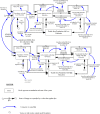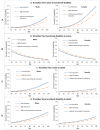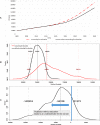Projection of young-old and old-old with functional disability: does accounting for the changing educational composition of the elderly population make a difference?
- PMID: 25974069
- PMCID: PMC4431717
- DOI: 10.1371/journal.pone.0126471
Projection of young-old and old-old with functional disability: does accounting for the changing educational composition of the elderly population make a difference?
Abstract
This study compares projections, up to year 2040, of young-old (aged 60-79) and old-old (aged 80+) with functional disability in Singapore with and without accounting for the changing educational composition of the Singaporean elderly. Two multi-state population models, with and without accounting for educational composition respectively, were developed, parameterized with age-gender-(education)-specific transition probabilities (between active, functional disability and death states) estimated from two waves (2009 and 2011) of a nationally representative survey of community-dwelling Singaporeans aged ≥ 60 years (N=4,990). Probabilistic sensitivity analysis with the bootstrap method was used to obtain the 95% confidence interval of the transition probabilities. Not accounting for educational composition overestimated the young-old with functional disability by 65 percent and underestimated the old-old by 20 percent in 2040. Accounting for educational composition, the proportion of old-old with functional disability increased from 40.8 percent in 2000 to 64.4 percent by 2040; not accounting for educational composition, the proportion in 2040 was 49.4 percent. Since the health profiles, and hence care needs, of the old-old differ from those of the young-old, health care service utilization and expenditure and the demand for formal and informal caregiving will be affected, impacting health and long-term care policy.
Conflict of interest statement
Figures





References
-
- United Nations. World Population Prospects: The 2012 Revision, Highlights and Advance Tables. Department of Economic and Social Affairs PD; 2013 Contract No.: Working Paper No. ESA/P/WP.228.
-
- Saw S- H. A decade of fertility below replacement level in Singapore. Journal of Biosocial Science. 1986;18(04):395–401. - PubMed
-
- Wen WK. Futures of Ageing in Singapore. Journal of Futures Studies. 2013;17(3):81–102.
-
- Lee WKM. Economic and Social Implications of Aging in Singapore. Journal of Aging & Social Policy. 1999 1999/October/29;10(4):73–92. - PubMed
Publication types
MeSH terms
LinkOut - more resources
Full Text Sources
Other Literature Sources
Medical

